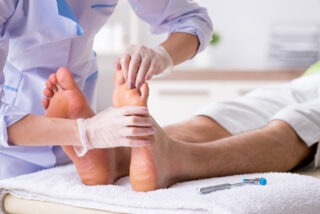
More Podiatry Foot Care Articles
Forefoot Surgery

Many foot problems do not respond to conservative management. Your podiatric physician can determine when surgical intervention may be helpful. Often, when pain or deformity persists, surgery may be appropriate to alleviate discomfort or to restore the function of your foot.
Bunions
A bunion, which is a common deformity of the foot, is an enlargement of the bone and tissue around the joint of the big toe.
When symptomatic, the area may become red, swollen and inflamed, making shoe gear and walking uncomfortable and difficult. If conservative care fails to reduce these symptoms, surgical intervention may be warranted.
Hammertoes
A hammertoe deformity is a contracture of the toe(s), frequently caused by an imbalance in the tendon or joints of the toes.
Due to the buckling effect of the toe(s), hammertoes may become painful secondary to footwear irritation and pressure. Your podiatric physician may suggest correction of this deformity through a surgical procedure to realign the toe(s).
Neuroma
An irritation of a nerve may produce a neuroma, which is a benign enlargement of a nerve segment, commonly found between the third and fourth toes. Several factors may contribute to the formation of a neuroma.
Your podiatric physician will likely x-ray the affected area to determine the size and severity of the neuroma and suggest a treatment plan. If conservative treatment does not relieve the symptoms, your podiatric physician will then decide on the basis of your symptoms, and whether surgical treatment is appropriate.
Bunionette (Tailor’s Bunion)
A protuberance of bone at the outside of the foot behind the fifth (small) toe, the bunionette (or small bunion), is caused by a variety of conditions including heredity, faulty biomechanics (the way one walks) or trauma, to name a few. Pain is often associated with this deformity, making shoes very uncomfortable.
If severe and conservative treatments fail to improve the symptoms of this condition, surgical repair may be suggested. Your podiatric physician will develop a surgical plan specific to the condition present.
Bone Spurs
A bone spur is an overgrowth of bone, as a result of pressure, trauma or reactive stress of a ligament or tendon. This growth can cause pain and even restrict motion of a joint, depending on its location and size. Surgical treatment and procedure is based on the size, location and symptoms of the bone spur. Your podiatric physician will determine the surgical method best suited for your condition.
Article provided by the American Podiatric Medical Association.

















